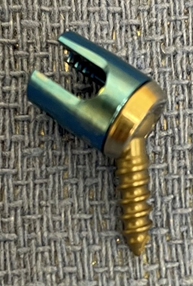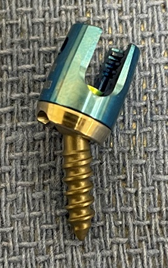The tops of the screws have a tulip. The tulip is typically polyaxial such that the rotation allows capture of the rod. In the picture below, the tulip is silver and blue part that does not have treads. If you look at the screw, the silver collar that rotates has a notch. This notch allows the screw to sit closer to the tulip and is what allows for the increased angle in this direction.

Screws are placed as part of a larger construct in which they are connected with rods. The rods often need to be bent in order to match the position of the screw tulips to seat properly. Bending the rods to exactly match the screw position is not always easy. Therefore the movement of the tulips allow for some latitude such that the tulip will move to the rod. This movement is limited and if more adjustment is needed then the rod will need to be bent more or the screw will need to be repositioned.
The movement of the tulip is greater in a particular direction and is referred to as the favored angle. Therefore if more angulation is needed in a particular direction the tulip can be adjusted to allow for greater angulation. Below are two pictures compared the preferred angle and not the preferred angle. I guess I’ll call it the orphan angle? There might be an actual name for the not preferred angle, but I’m not sure what that is.


The increased angle positioner is used to change the direction of the preferred angle without advancing or backing out the screw. The increased angle positioner is placed into the screw just like screw inserter. The positioner is rotated until the silver sleeve of the tulip is captured. Once captured the positioner is rotated until the preferred angle is in the desired direction.
